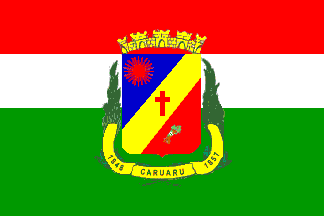 image by Joseph McMillan
image by Joseph McMillan
Last modified: 2010-10-22 by ian macdonald
Keywords: brazil | pernambuco | caruaru |
Links: FOTW homepage |
search |
disclaimer and copyright |
write us |
mirrors
The flag is at
www.supranet.com.br/clientes/dcmark/dps/janelas4/jan136.htm.
Joseph McMillan, 6 February 2001
The flag of Caruaru is an unequal horizontal tricolor field--green,
white, and red--whose length is one and a half (1 1/2) times its
width. The lower half of the field is emerald green, symbolizing the fertility of
the soil; the middle stripe, equal to one quarter of the hoist, is white,
the symbol of pacifist ideals; the upper stripe, also one quarter of the
hoist, is red, symbol of the haughtiness of its people. On the center is
the coat of arms, pointed at the bottom, tierced per bend sinister, its width
measuring one quarter the length of the flag, and its height, one third
the length of the flag. The upper part of the shield is blue,
representing the loyalty of the people, with a flaming sun signifying majesty,
fame, and the richness of the land. The bend sinister is yellow (gold),
signifying nobility and magnanimity, with a red Latin cross, symbol of the
Christian faith and of the catechesis of the natives of the region. The
lower part is red, signifying the courage and audacity of
the people, charged with a sheaf of hazel branches representing the
tenacity of José Rodrigues de Jesus, founder of the city. The shield
is topped with a yellow mural crown, attributed by the official
description as "a symbol of the resistance that led to the progress of the
region and the sovereignty given to it by the fame of the Princess of
the Agreste [dry, infertile lands of northeastern Brazil, 'Princess of the Agreste'
presumably being a nickname for the municipality]."
The yellow motto scroll has the dates 1848 and 1857 flanking the word
"Caruaru," recalling the dates of the creation of the municipality
and its elevation to the category of city respectively, and at
each end a branch of laurel, "won in the socio-economic battles
for the development of the Fatherland.
Dov Gutterman, 26 February 2002
Translated by Joseph McMillan, corrected by Jorge Candeias